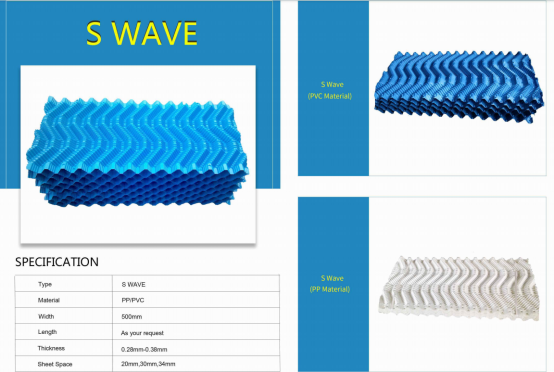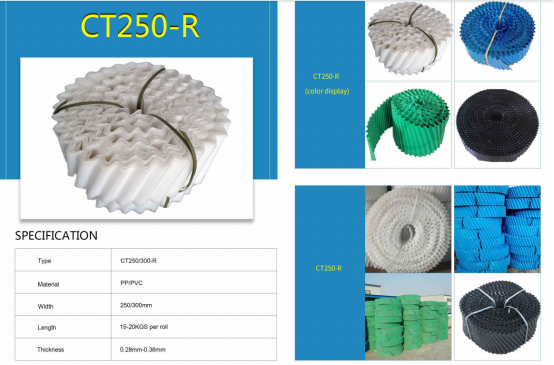Cooling tower infill plays a critical role in the thermal performance and efficiency of cooling towers. As the main medium for water and air contact, infill directly affects heat transfer, water distribution, and energy consumption. Selecting the right material is therefore essential for long-term performance, cost control, and reliability.
Two of the most commonly used materials are PVC (Polyvinyl Chloride) and PP (Polypropylene). While both have widespread industrial applications, their properties, advantages, and limitations differ significantly. This guide provides a detailed comparison to help you make the right choice for your cooling tower project.

Properties:
Made from polyvinyl chloride, often with additives for fire resistance and UV protection.
Commonly available in film fill or splash fill designs.
Advantages:
Excellent heat transfer performance due to smooth surfaces and good water film formation.
Fire-retardant properties when treated with additives.
Cost-effective compared to PP, making it a popular choice for HVAC and industrial cooling towers.
Widely available and proven track record across industries.
Limitations:
Maximum working temperature is generally ≤ 60°C, which restricts its use in high-temperature environments.
Can become brittle over time when exposed to UV radiation if not properly protected.
Properties:
Manufactured from polypropylene, a polymer with higher temperature tolerance.
Typically used in heavy-duty cooling applications.
Advantages:
High temperature resistance, withstanding up to 85–90°C, making it ideal for power plants, chemical processing, and steel mills.
Stronger mechanical properties, reducing risk of deformation under load.
Better resistance to certain acids, alkalis, and industrial chemicals.
Longer service life in demanding conditions.
Limitations:
Higher cost compared to PVC infill.
Slightly lower thermal performance than PVC in standard HVAC applications.
Heavier and may require stronger support structures.
Feature | PVC Infill | PP Infill |
Heat Resistance | ≤ 60°C | ≤ 85–90°C |
Thermal Performance | Excellent for standard cooling | Good, stable under high temp loads |
Fire Resistance | Good with additives | Moderate (less fire-retardant) |
Cost | Lower (economical choice) | Higher (premium choice) |
Chemical Resistance | Moderate | Higher |
Durability | 5–10 years (depending on use) | 10–15 years (demanding use) |

Selecting the appropriate cooling tower infill material requires a careful evaluation of operating conditions, cost considerations, and safety requirements. The following criteria can guide the decision-making process:
1. Operating Temperature
PVC Infill: Suitable for HVAC systems and general industrial cooling applications where operating temperatures remain below 60°C. Its thermal performance and cost-effectiveness make it the preferred option for standard environments.
PP Infill: Recommended for high-temperature environments such as power generation, metallurgy, and chemical processing, where operating conditions may reach 85–90°C. PP maintains structural stability and performance under elevated thermal loads.
2. Budget Considerations
PVC Infill: Provides an economical solution with lower upfront investment, making it practical for projects where capital expenditure is a priority.
PP Infill: Although more expensive initially, PP offers a longer service life and reduced risk of deformation or early replacement, resulting in better lifecycle cost efficiency in demanding conditions.
3. Chemical Resistance
PVC Infill: Adequate for standard water cooling operations with moderate exposure to treatment chemicals.
PP Infill: Exhibits superior resistance to acids, alkalis, and industrial chemicals, making it the safer and more reliable choice for facilities with aggressive water chemistry.
4. Fire Safety Requirements
PVC Infill: When enhanced with fire-retardant additives, PVC provides compliance with stringent fire safety regulations and is widely accepted in facilities where flame spread risk must be minimized.
PP Infill: Generally less fire-retardant compared to treated PVC, and therefore may not be suitable where strict fire safety compliance is required.

Both PVC and PP cooling tower infill materials have unique strengths. PVC infill is widely used for standard cooling operations due to its cost-effectiveness and good thermal performance, while PP infill is the material of choice for high-temperature and chemically aggressive environments where durability and strength are critical.
By carefully evaluating operating conditions, budget, and compliance requirements, you can select the right cooling tower infill material that ensures long-term efficiency and reliability for your cooling system.